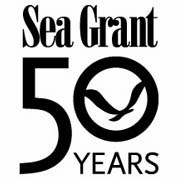On March 8, Sea Grant will celebrate its 50th anniversary. In 1966, President Lyndon B. Johnson signed The National Sea Grant College Program Act, and today, that program reaches every coastal and Great Lakes state, as well as Puerto Rico and Guam.
Over the past 50 years, Sea Grant’s research, education and outreach activities have encompassed diverse issues relevant to local, regional and national priorities, such as healthy coastal ecosystems, resilient communities and economies, sustainable fisheries and aquaculture, and environmental literacy and workforce development.
In 2010, 123.3 million people, or 39 percent, of the nation’s population lived in counties directly on the shoreline. Coastal economies are a driving force for the economy of the nation as a whole, and Sea Grant has become an important part of this sector. The program regularly creates or sustains an average of 9,300 jobs and 2,825 businesses each year, and it has also provided over 1,000 fellowships to John A. Knauss Marine Policy Fellows.
By drawing on the expertise of more than 3,000 scientists, engineers, law and policy specialists, public outreach experts, communications professionals and educators from more than 300 institutions across the country, Sea Grant is unique in its ability to quickly transfer research to application.
The Georgia Sea Grant College Program’s own research projects offer a full spectrum of problem-oriented and applied studies to address community issues. Investments in education and outreach programs generate nearly $112.6 million in economic impact for the state of Georgia each year. For over 40 years, Georgia Sea Grant has boosted coastal economic development by fueling discoveries through research, training students and developing workforce through education programs and engaging with stakeholders through marine extension programs.
Georgia Sea Grant has assisted in making the state safer and more resilient to coastal hazards, such as flooding, storm surge and sea level rise. These preparations have translated into real economic impacts through FEMA’s Community Rating System, which has saved Georgia property owners more than $7 million in annual flood insurance discounts.
In the fall of 2015, UGA Marine Extension and Georgia Sea Grant launched Georgia’s first oyster hatchery, which has the potential to harvest $1.6 million worth of oyster spat per year by 2018. Additionally, the educational programs offered by Georgia Sea Grant and its partners typically reach over 28,000 members of the general public and 6,100 preK-12th grade students, creating a new generation of students passionate about science and learning.
As the U.S. population continues to grow, the next 50 years will bring new environmental and economic challenges, and Sea Grant’s expertise and place-based support will become even more vital to America’s coasts.


